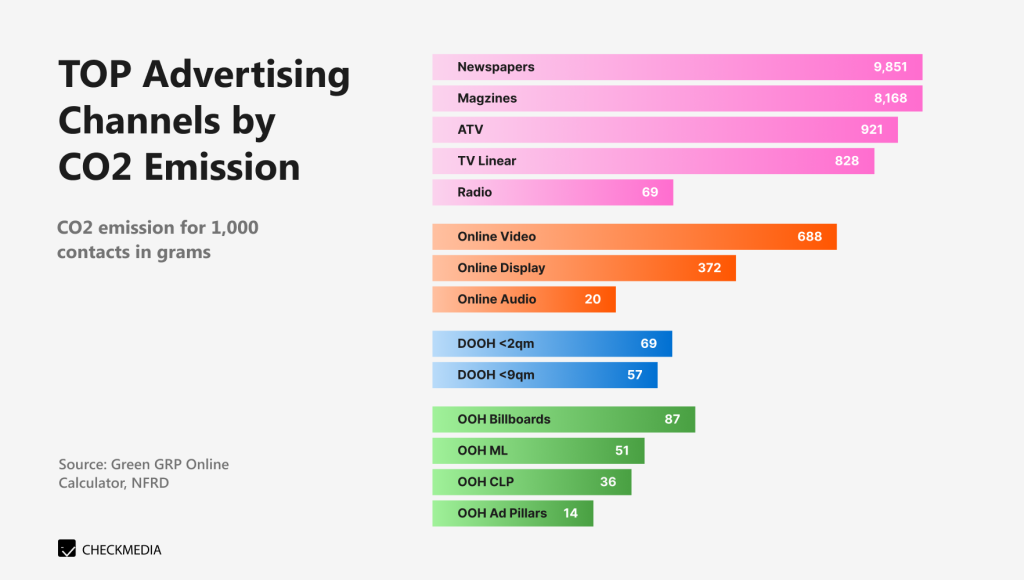
|
Achieve Marketing Sustainability and Effectiveness with a Smart Tool
In today’s rapidly evolving business landscape, companies are increasingly recognizing the importance of sustainability and environmental responsibility. One area that has garnered our attention is the role of sustainable marketing in influencing carbon emissions.
CheckMedia’s approach to sustainable marketing practices
At CheckMedia, we recognize that conventional advertising channels can contribute significantly to greenhouse gas releases. Hence, we have adopted a proactive stance in addressing this concern through the examination of CO2 releases linked to diverse advertising channels. Through the utilization of data from credible sources like the Green GRP Online Calculator, we have acquired valuable perspectives on the carbon footprint per 1,000 contacts (in grams) for different marketing channels, all within the framework of sustainable advertising.
Marketing channels’ eco-impact scale

Let’s take a closer look at some of the key findings from our analysis:
- TV Linear: Traditional linear television advertising, while still popular, has a substantial carbon footprint. For every 1,000 contacts, it accounts for approximately 828 grams of CO2.
- Advanced TV (ATV): Advanced TV advertising, including connected TV and addressable TV, also contributes to carbon emissions. The CO2 per 1,000 contacts range from 921 to 948 grams.
- Radio: Radio advertising is relatively more environmentally friendly, with only 69 grams of CO2 per 1,000 contacts.
- Magazines: Print magazines, although widely circulated, have a significant carbon footprint. On average, they generate approximately 9,851 grams of CO2 per 1,000 contacts.
- Newspapers (Nordic): Nordic newspapers, with their distinct format, contribute around 8,168 grams of CO2 emissions per 1,000 contacts.
- Online Channels: Online advertising channels offer a range of CO2 emissions per 1,000 contacts. Display ads account for 372 to 396 grams, video ads range from 688 to 716 grams, and audio ads generate only 20 grams of CO2.
- DOOH (Digital Out-of-Home): DOOH advertising, which includes various digital signage formats, exhibits lower emissions compared to traditional OOH channels. For example, DOOH on smaller screens (<9qm) contributes 5 to 57 grams, while smaller screens (<2qm) generate 6 to 69 grams of CO2 per 1,000 contacts.
- OOH (Out-of-Home): Traditional OOH advertising methods, such as billboards, advertising pillars, and ML (medium-large) formats, produce varying levels of CO2 emissions. OOH ML generates 50 grams, CLP (city light posters) contribute 36 grams, and billboards account for 87 grams of CO2 per 1,000 contacts.
Tool for more sustainable marketing
By factoring in these greenhouse gas emission statistics, CheckMedia can craft customized marketing strategies that uphold environmental sustainability while maintaining reach and efficacy. We give preference to channels with diminished emissions, encompassing radio, online ads, and DOOH, all within the framework of sustainable marketing. Concurrently, we actively explore avenues to curtail emissions in alternative channels through meticulous optimization and strategic planning.
We rely on an advanced AI-powered marketing mix modeling tool that can optimize strategies taking into account marketing activities, macroeconomic situation and other external factors as well as sustainability factors. Here you can learn more about the MMM solution we use.
With CheckMedia, you can build an optimal marketing mix that not only drives sales effectively but also minimizes the environmental footprint of your campaigns.
Our team of experts collaborates closely with clients to grasp their business objectives and formulate tailored marketing strategies in harmony with principles of marketing sustainability. We scrutinize the target audience, industry dynamics, and brand values to pinpoint the optimal advertising channels that adhere to the smallest carbon footprint.
Additionally, we actively seek opportunities to incorporate renewable energy sources, such as green electricity, into our marketing campaigns. By utilizing green electricity, we further reduce the carbon releases associated with our clients’ advertising activities.
There have been a few updates and introductions in sustainability standards for enterprises recently. The Corporate Sustainability Reporting Directive (CSRD) which came into force on 5 January 2023 will make corporate sustainability reporting more common. In 2025, European companies that SCRD applies to will have to provide first reports on how their activity impacts people and the environment.
As sustainability continues to be a crucial aspect of business operations, partnering with CheckMedia allows companies to enhance their brand reputation, engage eco-conscious consumers, and contribute to a greener future. Together, we can achieve marketing success while preserving our planet.



